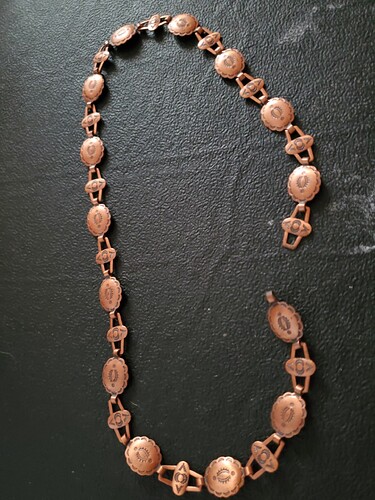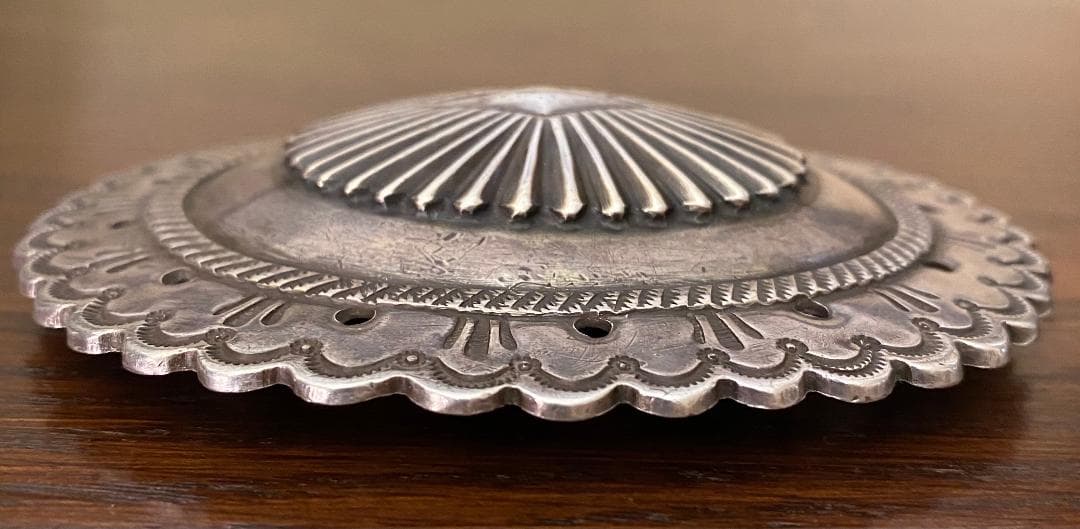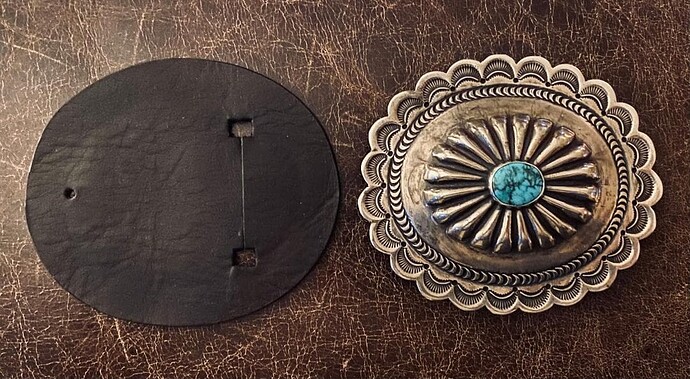Good question. We had a discussion about a buckle of mine that might interest you. Scrimshaw buckle…deer or elk antler?
Anyone seen copper used? I have this petite belt but unsure if its authentic or costume…Different nonetheless.
[Uploading: 20240813_132151.jpg…](
I think companies such as Bell Trading Post and Fred Harvey made copper items. Is there a hallmark?
Not that i can find. Ty for the lead
It may have taken me a moment, but as promised @TAH, here are a couple photos of my converted concho buckle.
ca. 1920’s, 4" x 3 5/16", 100.43 grams
When I can align my spare moments with preferable natural light, I’ll share some other buckles and belts I’m certain you’ll appreciate.
Regards,
Aaron
I believe, @TAH, that you and I have been on a very similar hunt for years. I know full well that you have reaped succes, and I was elated in finding that out here, but I thought I’d share with you something I’ve not seen posted on the forum. Though I won’t be surprised in the slightest if you’ve known of this.
I watched a “promotional” video, a couple of years ago, posted on Youtube, by the Durango Silver Company. While watching that video I took a screenshot on my phone for future reference, and as ammunition for the afformentioned hunt, which at that point had been ongoing for roughly 2 years. Below are (2) screenshots, showcasing, although rather blurred, a treasure you were able to acquire from Fine Arts of the Southwest. I just about fell out of my seat, as this one appears to be on it’s original leather, with original conchos and butterflies. I attempted to reach out to John Hartman to inquire as to the availability of the belt, but I was apparently a bit too late.
I thought you’d enjoy!!
Regards,
Aaron
Hi Aaron,
Thank you for the photos of your outstanding concho buckle! You have great taste! ![]()
Believe it or not, I am familiar with this specific buckle from an email exchange with its previous owner back in October 2023. We agreed that our buckles were so similar that there was a good possibility they were made by the same hand. Glad to see it ended up in your hands. Here are some close-up photos of my buckle followed by a photo of your buckle the previous owner sent me. As you can see, my concho was converted later in life considering the commercial findings on the back.
4" x 3 3/8", 101 grams, ca. 1920
Your buckle…

Are you just a collector or do you wear your buckles, as well? Also, tell me a little about the beautiful rifle.
Back again Aaron,
Oh, I am very familiar with that belt (and buckle). It is still referenced on Durango Silver’s website under “Antique Indian Silver Jewelry Examples”.

Above is a beautiful antique Navajo Indian handmade Silver Concho Belt , made from coin Silver. Each Silver piece is slightly different in thickness which tells us the the Silver was pounded out from Silver ingots that were poured from molten Silver. This piece of Antique Indian Silver Jewelry is a great example of a American Indian Silver Concho Belt that was made prior to 1911, which makes this piece an antique.
Here’s another photo I found…

Durango’s date of “prior to 1911” might be true of the conchos, spacers, and leather, but I am highly doubtful the buckle is original to the belt, as it was quite common for buckles to be replaced along the way. That said, it is still a great looking package.
As you are probably aware there are few of these sandcast buckles out there. All research points to them being made in 1950s for the commercial market. Even though these buckles were cast in multiples, it is still one of my very favorite sandcast designs with its solid central frame and flowing arms. In August, I was able to see the Heard Museum’s example…
Here’s another photo of my buckle…
4" x 3 1/4", 143 grams, ca. 1950
Thanks for bringing the belt to my attention again. I never get tired of seeing it.
I am intrigued, fascinated, and I must admit, NOT surprised ![]() , that you had contact with my buckle’s original caretaker, what could possibly be the odds?! I’ve got the close up photos of your buckle saved, as I’ve often admired it, and have used them for reference during research. Thank you for sharing them again, as well as the correspondence you had with the former owner, that was a joy to read. I had an inkling that these two buckles could possibly be related, both of them certainly have similar characteristics. Regardless of the age of the pin and swivel (or loop), I think yours is absolutley stunning, a truly well made, beautiful concho. (Yours will lay much more flat than mine as well
, that you had contact with my buckle’s original caretaker, what could possibly be the odds?! I’ve got the close up photos of your buckle saved, as I’ve often admired it, and have used them for reference during research. Thank you for sharing them again, as well as the correspondence you had with the former owner, that was a joy to read. I had an inkling that these two buckles could possibly be related, both of them certainly have similar characteristics. Regardless of the age of the pin and swivel (or loop), I think yours is absolutley stunning, a truly well made, beautiful concho. (Yours will lay much more flat than mine as well ![]() ).
).
I would consider myself a fairly serious collector, who wears his collection. Though my time spent crafting leather is lacking, I’ve only succeeded in getting one belt made to accomodate a leatherless concho belt/buckle I purchased. I’ll share that belt and a few others the moment I can conjure up some photos. I prefer the wider belts on concho belts, and I’m needing to craft some ranger style belts to accomodate a few of my buckles that have narrower loops.
Depending on what part of the state you reside in, you may know where that rifle came from. It’s a well traveled .30-30 Winchester Model 1894 native american trade gun, ca. 1898, (per the previous owner). I purchased it from a man somewhat local to me, and it crossed his path through the hands of a native that blessed his bison preserve, in it’s infancy. A condensed version of it’s history follows. His parents took him, as a child in the 1960’s, to Yellowstone and he put his eyes on an American bison for the first time. He has shared with me that after learning how integral their role was to the landscape and history of this land, he vowed he would create a preserve where they could flourish. After many years of hard work, sacrifice, and time spent in college, he opened his own medical practice in Ohio, and using those means, was able to purchase an abandoned campground and start as well as maintain the preserve. He originally purchased 5 head from Custer State Park, and, last I knew, he has 350 or so head. With 500 acres, he’s got plenty of room for natural fluctuation. The most he had at one point is ~480 I believe. The rifle is strictly decoration, somewhere along it’s path lies the original saddle ring, the stock and forend are wrapped in bison hide, held in place with copper wire and brass tacks, that I dare don’t remove to verify it’s age, the serial number is hidden by this (as I’m sure you know) very old manner of holding a broken stock together. It means a great deal to me, as does my spending time at the good doctor’s preserve. Being there is a complete reset for me, and is reminiscent of time I spent in Alaska, just simple, unhurried beauty, all around. The picture I utilized for my avatar was taken while spending a weekend at the preserve’s lodge last year. Two bulls had bumped into eachother, which quickly led to them squaring off, and I couldn’t capture it quickly enough.
Regards,
Aaron
I have come across the second photo you posted as well, I can not recall the site, but I have seen that photo.
Thank you for sharing what you learned in your chase of this particular buckle, it has been a treat to learn from you and what you provide to this community. The Durango belt is certainly a great looking package, and although my original post on this may have been a bit knee-jerk, I agree that this buckle is not original to that belt. As you mentioned, it was commonplace for buckles to be either swapped out or replaced at some point in a belt’s life. I have seen, (and I know you have as well) very early, first phase belts, with buckles that clearly are not original, either far too large or complex, as opposed to the smaller, much simpler early buckles.
It may have been cast in multiples, but it is my absolute favorite pattern as well. There are plenty of other beautiful examples showcasing the art of the buckle, but for me, in the cast realm, this one is unrivaled.
I recall reading about your trip and visit to the Heard, are they going to return your collection to you anytime soon? ![]() Thank you for sharing those photos! The last picture of your buckle and belt is incredible, thanks again!
Thank you for sharing those photos! The last picture of your buckle and belt is incredible, thanks again!
Regards,
Aaron
Thought I would add a little content to one of my favorite threads. Below is a converted concho buckle attributed to Hosteen Goodluck by several experts (according to the reputable gallery I purchased it from) and by Bill Malone, who sold it to its previous owner at Hubbell Trading Post in 1996. Before I purchased it, I sent detailed photos to Bill, who remembered the buckle and confirmed it was indeed made by Hosteen.
Of course, without a hallmark or other ironclad provenance, attributions are just attributions, but I feel pretty good about this one knowing Bill’s life-long experience and that many of Hosteen’s pieces went through his hands, perhaps due to his wife being Hosteen’s granddaughter.
Regardless of who actually made it, I still love this buckle for its superior craftsmanship, precision stamp work, and beautiful stone. I made the leather backing for no other reason than I like how it looks. ![]()
Likely Lone Mountain turquoise, 3 5/8" x 3 1/8", 77 grams, ca.1930.
Hosteen Goodluck, 1904
Beautiful buckle, Tom. Love the precision and artistry used in making the stamps, as well as the expertly crafted silverwork. Really a classic piece!
Tom,
This is an absolute tresure. Beautifully well executed and very attractive turquoise. As @mmrogers mentioned, the precision in the stamps certainly stands out, as do their application to the concho. Your leather backing really sets it off and it looks amazing on your belt! Thank you for sharing!
For those of us that prefer the earlier works, all we have to go on is the provided story of the piece, attributions, quality of workmanship (which this undoubtedly has) and our knowledge of the early ways. The provenance you shared carries much weight, and should not be taken lightly.
Wonderful addition to your fine collection, Tom.
Regards,
Aaron
Thanks Mike and Aaron! Appreciate the kind words. Sometimes I forget the art isn’t just in the finished stamp work, but in the talent and detail it takes to create the tools and dies for the stamp work, as stated in this writeup from Browns Trading Company…
GOODLUCK, HOSTEEN, De-she-na-te (Navajo, c. 1860s-1937) was widely respected as one of the most important, early Navajo silversmiths. He was a master jeweler and active from the 1890s to 1930s. A “First Phase” silversmith that worked for C.G. Wallace as early as 1923. C.G. Wallace was so impressed with the talents of this man that he moved Hosteen from Houck, AZ to Zuni, NM, to do cast work and as a die maker. C.G. supplied him with fine Swiss files, which he used to make sets of dies. Many of Hosteen’s dies were furnished to other Zuni and Navajos, with C.G. encouraging them to do silver work. Hosteen was a master in hand-hammered, bezel set, stamp work and repousse’ silver jewelry.
Particularly impressed with the sunburst scallop stamps used around the outside of the concho. To make it the silversmith used a straight slightly trapezoid stamp for the radial line work, a meticulously crafted curved stamp to create the curved separation which gives the stamp its unique character, and then expertly shaped the stamp with round and flat files to create the beautifully executed scallop shape. The stamps used to make the stamp, as well as the stamp itself took many hours of meticulous work to fashion by hand.
Mike, thanks so much for the detailed explanation. Really interesting! All of you jewelry makers impressive me. I sincerely admire and envy your skill and talent. All I’m good at is making milkshakes for the kids. ![]()
I guess it’s a mutual admiration society then,Tom. I suspect you’re a true master of your trade, and really admire your collections, and passionate dedication to fine Native American silverwork, and artwork.
Mike, I have come to have the utmost respect for you and your approach to sharing your vast knowledge. Your professional, objective views never faulter and your know-how of silversmithing and all that this craft entails is highly regarded by myself, obviously by Tom, and I’m sure by many others here. Your words and thoughts on the execution of countless pieces here should be catalogued. I always enjoy seeing your responses, as I’m certain to learn.
Regards,
Aaron


















